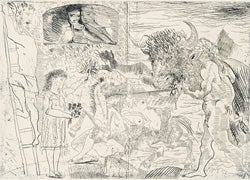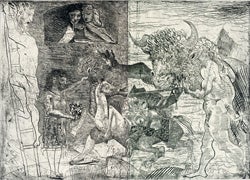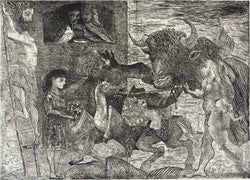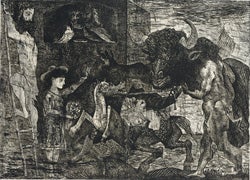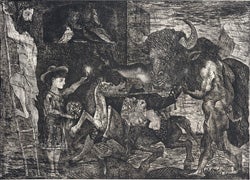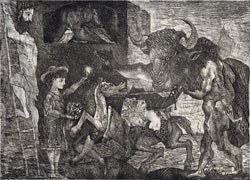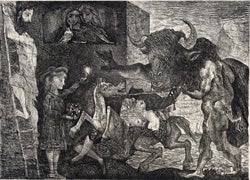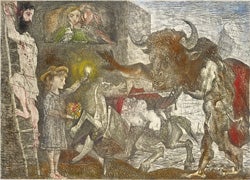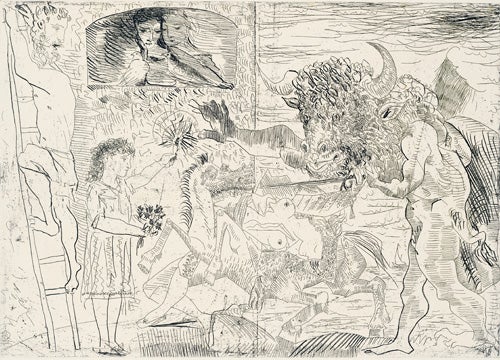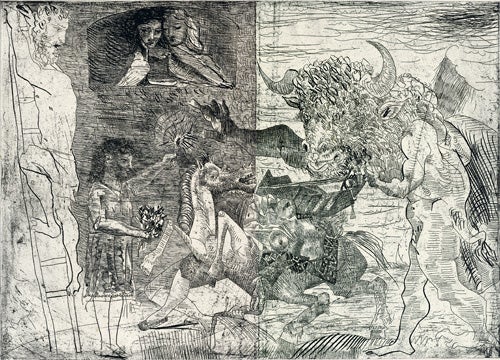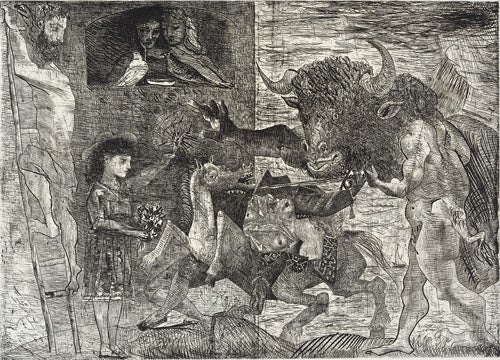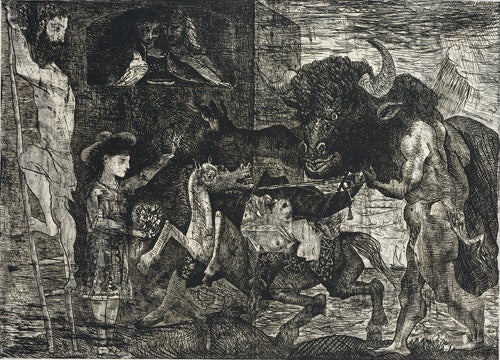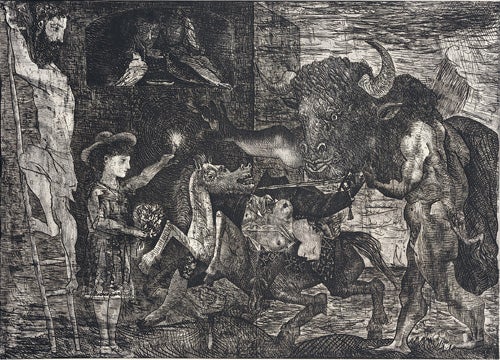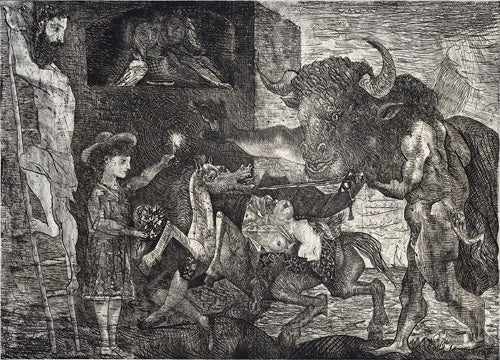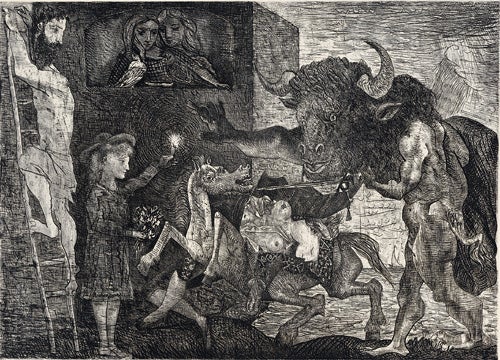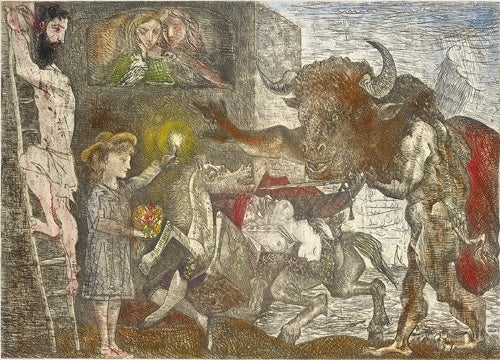Picasso's Greatest Print: The Minotauromachy in All Its States
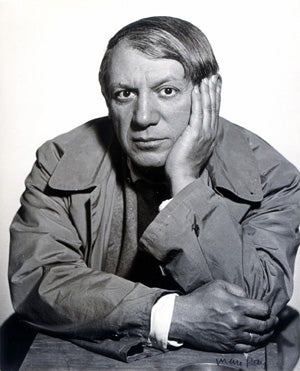
Pablo Picasso, 1934, photograph by Man Ray, gelatin-silver print, J. Paul Getty Museum, Los Angeles.Minotauromachy (state VI), 1935, etching; additional work with scraper and burin, 19 1/2 x 27 1/4 in. (49.5 x 69.3 cm), private collection.
|
A House Divided |
||
|
PABLO PICASSO (1881–1973) achieved genius in every medium in which he worked: painting, sculpture, drawing, printmaking, and ceramics. From his early work at the turn of the nineteenth century to his final production seven decades later, his prodigious oeuvre defines what we call modern art. Printmaking held a central place for Picasso throughout his life, and he became one of the finest and most prolific printmakers of all time. |
Minotauromachy was produced during what Picasso would later describe as "the worst time in my life." Two years later, he would adopt much of the print's imagery for his great mural painting Guernica his outraged response to the Spanish civil war.
November 16, 2006February 25, 2007 |
|
|
The States of the Minotauromachy |
|
PICASSO DEVELOPED THE FINAL COMPOSITION of Minotauromachy over several weeks, from March to May of 1935. This is the only complete set of all seven states, including the colored version of the seventh state. After completing the print, in preparation for an edition that would number up to fifty, Picasso had the copper plate "steel-faced," a process in which a thin electroplated coating of steel is applied to the surface of the plate to preserve the quality of printing through an entire edition. Steel-facing can diminish a print's vibrancy; all of the impressions of this set, with the sole exception of the colored seventh state, are pre-steel-facing. Only numbers 16 and 31–32 are known to exist from the final edition; indeed, Picasso himself did not know how many impressions of the final edition were actually printed. |
The exhibition now on display at LACMA comprises the only complete set of all seven states. |
|
|
|
THOUGH ONLY LIGHTLY ETCHED, the overall composition is already laid out in its final configuration. Forms consist primarily of outline, with little shading or modeling. Only a few areas are darkly "bitten" (the action of the acid bath that burns through the exposed parts of the copper plate, creating the lines that will ultimately be inked): these include the Minotaur's mane, his right hand and arm, his cape, the hair and flowers of the standing girl, the interior of the arched window, and some sections of ground and sky. At this stage, the standing girl has dark hair and wears no hat. The print's central axis is defined by the edge of the background building, which lacks the receding wall that will appear in state IV. Picasso has etched under the ladder at left: "Paris, Samedi 23 mars XXXV" (Paris, Saturday 23 March [19]35). |
Minotauromachy (state I), 1935, etching; additional work with scraper and burin, 19 1/2 x 27 1/4 in. (49.5 x 69.3 cm), private collection. |
|
|
|
MUCH OF THE PRINT'S LEFT HALF has been darkened with stronger shading, especially on the building and the standing girl holding the candle. The Minotaur's right arm has also been darkened, as have the horse's head and body. More detail and fine horizontal lines have been added to the standing girl (whose face is now particularly dark with hatching), and the horse and the female matador are more fully defined and modeled, as are the two women at the window and the interior space behind them. The more finished head of the horse is closer now to the final version. The bearded man on the ladder and the body of the Minotaur remain lightly shaded contours. |
Minotauromachy (state II), 1935, etching; additional work with scraper and burin, 19 1/2 x 27 1/4 in. (49.5 x 69.3 cm), private collection. |
|
|
|
THE PRINT IS BLACKER OVERALL, as Picasso continues to work the plate—etching more lines, engraving directly with burin and scraper, and leaving the plate in its acid bath for longer periods to "bite" deeper grooves. The darker tonalities have begun to unify the composition. The standing girl now wears a hat. Her hair is still black, but her face has been lightened. The beard of the man on the ladder is more fully drawn, suppressing the open-mouthed expression of previous states, and his body is more fully modeled, as are the horse's neck and front legs. The Minotaur's head is much more detailed, and he is now planted more firmly on solid ground. The sky, clouds, and rain behind him are more defined. The female matador's face is lighter. The wall against which the ladder rests is now clearly delineated with finely etched lines. |
Minotauromachy (state III), 1935, etching; additional work with scraper and burin, 19 1/2 x 27 1/4 in. (49.5 x 69.3 cm), private collection. |
|
|
|
A SHIFT OCCURS as the etching is now, on the whole, darker, denser, and more tonally unified. The entire plate has been deeply rebitten, and additional work done with scraper and burin. Formerly clear details have become difficult to read. The building's receding wall, at center right, appears for the first time. The ground has been given a solid and uniform shape. The sky looks more menacing than in the previous state. Three dark lines (presumably the result of a printing accident) run across the legs of the standing girl and the lower section of the ladder. The horse, matador, and Minotaur are more fully modeled, and the inscription at lower left has been concealed with hatch marks. |
Minotauromachy (state IV), 1935, etching; additional work with scraper and burin, 19 1/2 x 27 1/4 in. (49.5 x 69.3 cm), private collection. |
|
|
|
The print is even darker and denser than the previous state. The dark-light contrast, or chiaroscuro, that will ultimately characterize the left and right halves of the image has not yet been fully articulated. The candle flame is more distinct, and the underside of the Minotaur's right arm is illuminated by a stronger light. The dark bands across the standing girl's legs have been reduced, and parts of the Minotaur's head have been lightened. The shading around the two women in the window has been heightened; they are now submerged in darkness, their former clarity obscured. |
Minotauromachy (state V), 1935, etching; additional work with scraper and burin, 19 1/2 x 27 1/4 in. (49.5 x 69.3 cm), private collection. |
|
|
|
THE ENTIRE ETCHING HAS BEEN LIGHTENED, resulting in a grayer tonality overall. The standing girl's hair, dress, and hat are now lighter and more legible. The halo around the candle is more pronounced. The Minotaur's head and right arm have been softened, the articulation of the biceps removed, and the underside of the arm made significantly lighter. The two women and the doves in the window have been clarified; the extreme shading of the previous state has been reduced. The building's receding wall has been lightened, especially below the Minotaur's horn. Lines delineating the sky are more uniform, and the clouds and rain appear less menacing. The dark bands across the standing girl's legs are now almost entirely gone. |
Minotauromachy (state VI), 1935, etching; additional work with scraper and burin, 19 1/2 x 27 1/4 in. (49.5 x 69.3 cm), private collection. |
|
|
|
THE TWO WOMEN IN THE WINDOW have been substantially reworked, given greater contouring and detail and more solid expressions; they have also been lightened, and the check pattern of the left-hand woman's dress has been extended to her left sleeve. The standing girl's hair has been lightened again, and the reflection on her face has been strengthened. The bearded man on the ladder has been further clarified, and there is an increased modeling of the Minotaur's head and extended arm. |
Minotauromachy (state VII), 1935, etching; additional work with scraper and burin, 19 1/2 x 27 1/4 in. (49.5 x 69.3 cm), private collection. |
|
|
|
THIS IMPRESSION was colored "à la poupée " (literally, "with the doll," a technique in which a doll-shaped bundle of fabric is used to dab colored inks into the etched lines of the plate, after which the plate's surface is carefully wiped so as not to smudge the colors). Picasso printed only one other Minotauromachy in color (now in the Musée Picasso, Paris). Here, he used red (for the Minotaur's cape, the female matador's sash, and individual flowers in the bouquet), pinkish tan (for the bodies of the Minotaur, the bearded man on the ladder, the standing girl, and the two women spectators), reddish brown (the ground, and the Minotaur's mane and extended arm), yellow (the candle flame, individual flowers, and the dress of the woman spectator on the left), and blue (the sky, the sea, and the dress of the standing girl). |
Minotauromachy (state VII, colored), 1935, etching; additional work with scraper and burin, and colored inks applied à la poupée, 19 1/2 x 27 1/4 in. (49.5 x 69.3 cm), private collection. |
|
Acknowledgments |
|
IN 1966 PICASSO CREATED a color lithograph, specially commissioned by LACMA's Graphic Arts Council (now called the Prints and Drawings Council), to commemorate the museum's exhibition Picasso: Sixty Years of Graphic Works; in 1994 LACMA organized the exhibition Picasso and the Weeping Women; and in 1998 we hosted Picasso: Masterworks from the Museum of Modern Art. Continuing in this tradition, it is a great privilege to present to the Los Angeles public this rare set of Picasso etchings. This is the first exhibition in the United States of the complete series. It has been organized with very little lead time, and we are especially grateful to our colleagues at the museum for their support: CEO and Wallis Annenberg Director Michael Govan, Nola Butler, Amy McFarland, Katherine Go, Renee Montgomery, and Cheryle Robertson. Thanks to Larry Gagosian and Mark Francis for their cooperation in bringing these prints to LACMA, and to the Wallis Annenberg Director's Endowment Fund for its support of this presentation. Stephanie Barron Kevin Salatino |
This exhibition was organized by the Los Angeles County Museum of Art. It was made possible in part by LACMA's Wallis Annenberg Director's Endowment Fund. All images of Minotauromachy © 2006 Estate of Pablo Picasso/ Artists Rights Society (ARS), New York; photos courtesy Gagosian Gallery, London. Photo of Pablo Picasso © Man Ray Trust/Artists Rights Society (ARS), New York/ADAGP, Paris; courtesy of J. Paul Getty Museum, Los Angeles. Picasso likeness © 2006 Estate of Pablo Picasso/Artists Rights Society (ARS) New York. Brochure © 2006 Museum Associates/LACMA. All rights reserved. |
